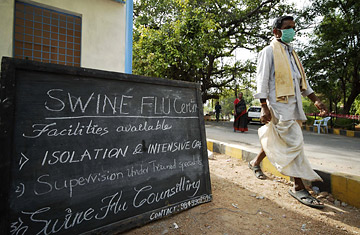
Outside a swine flu emergency ward set up at a government hospital in Hyderabad, India.
(2 of 2)
The problem is, if and when the flu does take root in the developing world, countries' lack of preparation could be devastating to their populations — especially those that are already so ravaged by endemic disease. The 1918 flu pandemic, for example, was estimated to have killed some 17 million Indians. So, how prepared is the developing world for another go around? That has been the topic of study for five years by the Communicable Diseases Policy Research Group at the London School of Hygiene and Tropical Medicine, which found that many African countries are without even basic plans for handling an influenza pandemic. And while many countries in other parts of the developing world do have detailed pandemic preparedness plans for flu that adhere to WHO guidelines, says Professor Richard Coker, the lead author for many of the group's papers, the question is, "When it comes down to it, can you actually implement your strategy? Do you have the resources? And if you do have the resources, can you allocate them properly? And the answer we're finding tends to be no."
Coker said his research group looked at the preparedness plans in all African countries, 17 countries in Latin America and selected countries in Southeast Asia. In Thailand, for example — a country with a relatively robust health care system — "we found that you need only have a very mild, very small pandemic to saturate the system. [Thailand doesn't] have enough ventilators, doctors or Tamiflu." Coker said that the Thai government and other governments in the developing world will likely be forced to make difficult decisions on how to allocate resources in the case of a pandemic, and these decisions should be made public early on to avoid causing social unrest.
Health officials in India appear to be heeding that advice already. While there is no panic or national state of emergency, the government's reaction to swine flu has been stronger than in other parts of the developing world. (India was badly affected by bird flu in 2008; in West Bengal, more than 2.5 million birds were culled, which ruined tens of thousands of rural families who relied on poultry farming.) On Wednesday, a non-resident ethnic Indian, who flew to Hyderabad in central India from the United States after visiting Mexico, was quarantined, suffering from suspected swine flu. Since then, the patient's symptoms have subsided, said Vineet Chaudhary, joint secretary of the Health Ministry, but blood samples have been taken and sent to Delhi for testing.
The Ministry has asked Indians to restrict travel to the United States, Mexico, Canada, New Zealand and France, where swine flu cases have been suspected or confirmed, and is checking all travelers flying into India from these countries for symptoms such as fever and upper respiratory tract infection. All passengers having traveled to India from any of these five countries during the last 10 days, estimated to number 50,000, are also being located and given a check-up. Screening and quarantine facilities have been set up at all India's 17 major international airports, where doctors and nurses are stationed around the clock. Those social-distancing measures may be the best tools available: The ministry says it has stocked 1 million doses of the antiviral oseltamivir, with plans to increase its reserves to 10 million over the next week, but that will do very little to control a pandemic in a country with over a billion people.
These safeguards are, however, stronger than they have ever been. "We are reaping the benefits of our experience with bird flu," says Dheeraj Singh, spokesman for the National Institute of Communicable Diseases in New Delhi, which is overseeing preparations for swine flu. "This time when the alert was sounded, we had experienced doctors already identified. We set up a helpline and placed large advertisements in newspapers. And cities where there are airports already have monitoring facilities." — With reporting by Madhur Singh / Delhi and Eben Harrell / London.
